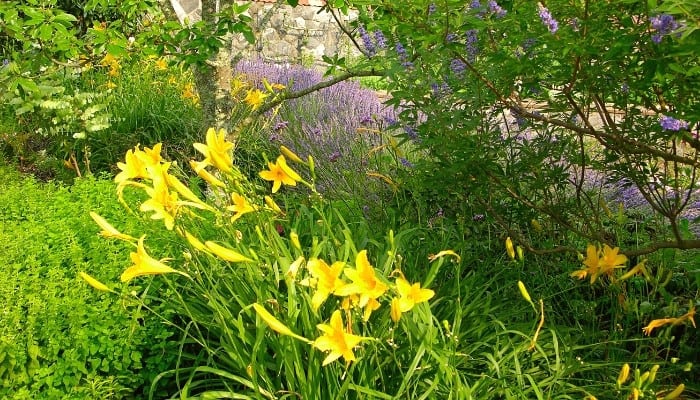The most prevalent type of Daylily is the yellow daylily (Hemerocallis lilioasphodelus ‘Stella D’oro’), however, there are also variations in pink, purple, orange, red, or cream.
The daylily requires full sun and well-drained acidic soil to thrive, and plant size can vary from 8 inches to 5 feet in height to 2-4 feet in width.
When planting companion plants with daylilies, select plants that survive in similar growth environments.
Avoid planting taller plants with daylilies as this will create too much shade and stunt the sun-loving daylily’s growth.
Daylilies will provide blooms throughout the summer and into the autumn, so planting them with interesting companion plants will create an ever-changing color canvas in your garden.
1. Dianthus
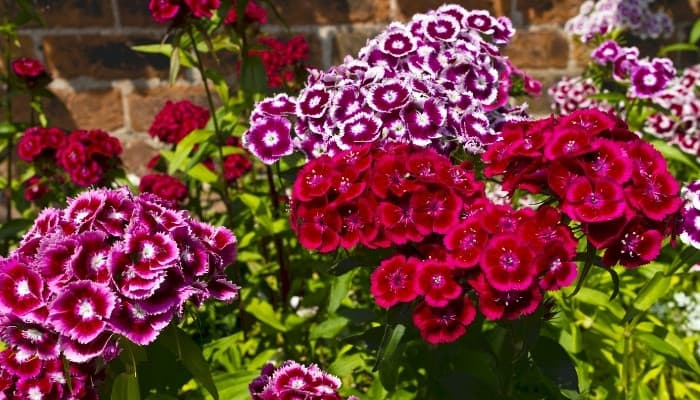
Many types of dianthus come in a fantastic array of shapes, colors, and sizes. Most have small feathery sweet-smelling flowers which bloom throughout the summer.
They are perfect daylily plant companions as they enjoy full sun to partial shade and well-draining soil. Plant as edging or bedding plants.
- Botanical name: Dianthus
- Average size: 6-18 inches (15-46 centimeters)
- Colors available: Red, salmon, pink, white, purple
- Popular varieties: Chinese pinks (Dianthus chinensis), Sweet William (D. barbatus)
2. Purple Cornflower
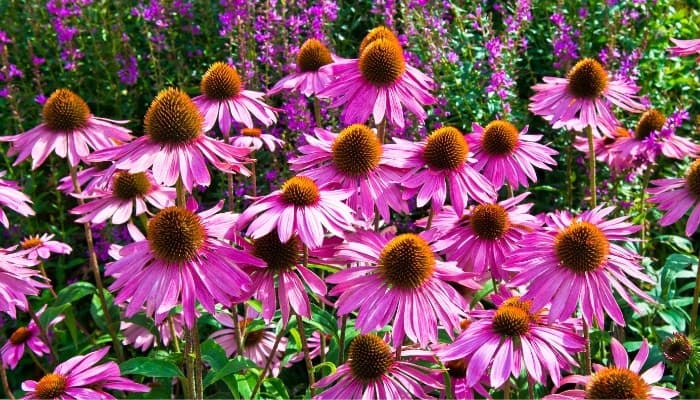
The purple cornflower produces flowers with downward-pointing petals and domed orange-brown centers. Flowers bloom from midsummer into autumn.
They thrive in full sun and moderately poor soils and can reach a height of 5 feet. Position purple cornflowers in between daylilies to provide additional body to the garden
- Botanical name: Echinacea purpurea
- Average size: 2-5 feet tall
- Colors available: Purple
- Popular varieties: Pink Double Delight, PowWow Wild Berry, Double Decker, Maxima
3. Zinnia
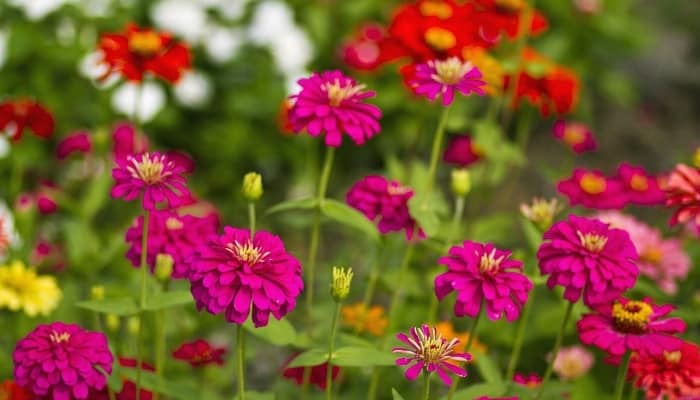
Zinnia’s come in many colors ranging from gold to brilliant red and orange. They prefer full sun with well-draining soil.
They can vary significantly in size from 10 inches to 4 feet and are great companions for daylilies when planted in a sunny border position. They provide a riot of color from early spring to late autumn.
- Botanical name: Zinnia
- Average size: Height 6 inches – 3 feet
- Colors available: White, gold, purple, orange, red, fuchsia, multicolored
- Popular varieties: Queen Red Lime, Uproar Rose, Peppermint Stick
4. Yarrow
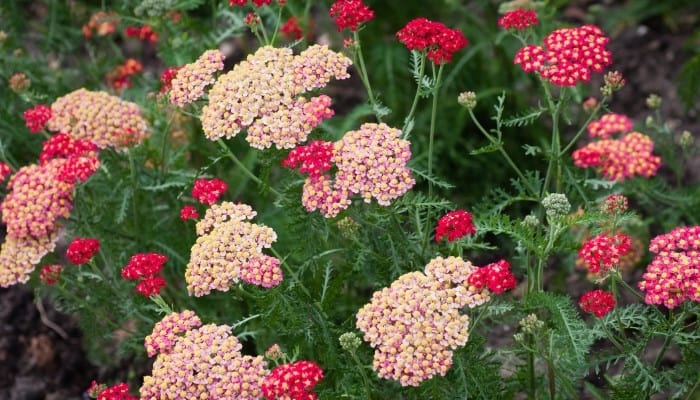
The yarrow plant produces clusters of daisy-type flowers on long woody stems that can reach 2-3 feet.
Yarrow requires full sun but can thrive in various poor or dry soil types; however, rich, well-draining soil is best.
Use low-growing yarrow in drier gardens as edging as it is drought tolerant. In addition, the plant’s root secretions can improve disease resistance in the daylily and other nearby plants.
- Botanical name: Achillea millefolium
- Average size: Height 2-3 feet, width 2-3 feet
- Colors available: Red, pink, yellow, white
- Popular varieties: Little Moonshine, Cerise Queen, Apple Blossom
5. Black-Eyed Susan
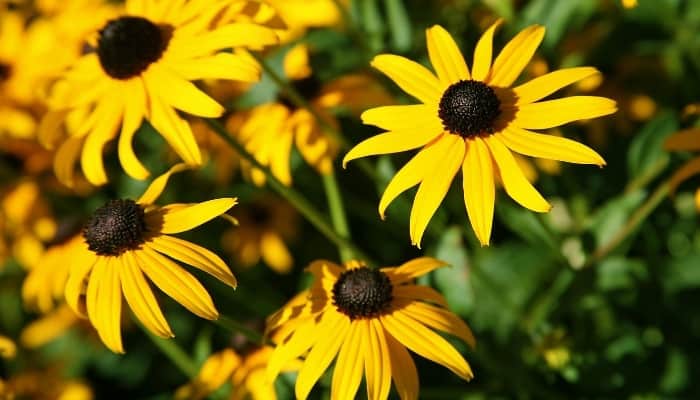
The flowers of the black-eyed Susan are yellow to orange with brown centers. They bloom in the summer and require full sun with moist to dry, well-draining soil.
They grow well in the same environment as the daylily and create pretty splashes of color when planted with daylilies.
- Botanical name: Rudbeckia hirta
- Average size: Height 2-3 feet, width 1-2 feet
- Colors available: Orange, yellow
- Popular varieties: Prairie Sun, Indian Summer, Moreno
6. Salvia
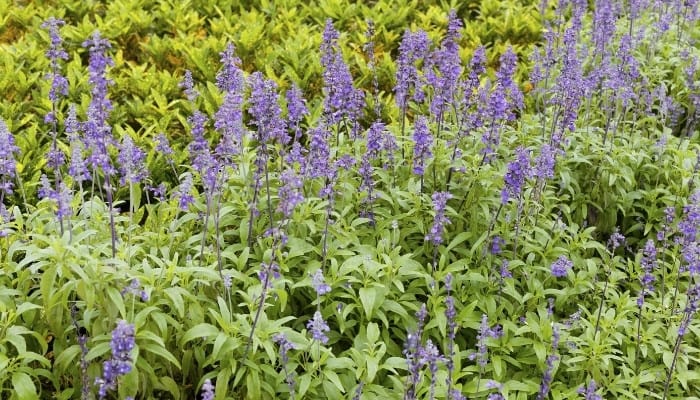
Salvia, or ornamental sage, blooms in the summer and produces spikes of hollow, tube-like flowers in colors ranging from purple to bright blue.
They look charming, grown in borders or planted under the taller daylily.
Salvia requires moist, well-draining soil and access to full sun, making them excellent companion plants for daylilies.
- Botanical name: Salvia officinalis
- Average size: 20 inches in width and height
- Colors available: Blue, purple, red, white
- Popular varieties: Amistad, Caradonna, Balkan sage, Gentian sage
7. Bee Balm
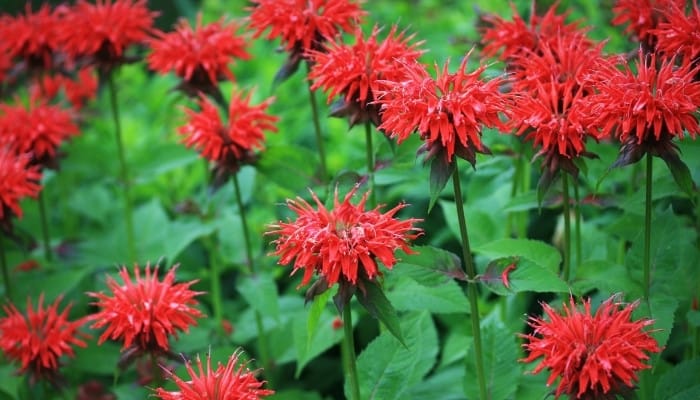
Bee balm enjoys lots of direct sunlight and moist loamy soil. It blooms best late summer into autumn, producing full, vibrant flower heads in red, purple, pink or white.
It is an excellent companion for the daylily when gardens become sparse as flowers start to die back late summer to early autumn.
- Botanical name: Monarda
- Average size: Dwarf height 10-15 inches, width 18-24 inches; Standard height 2-4 feet, width 3-4 feet
- Colors available: White, pink, purple, red
- Popular varieties: Monarda pringlei, Monarda didyma, Monarda fistulosa
8. Phlox
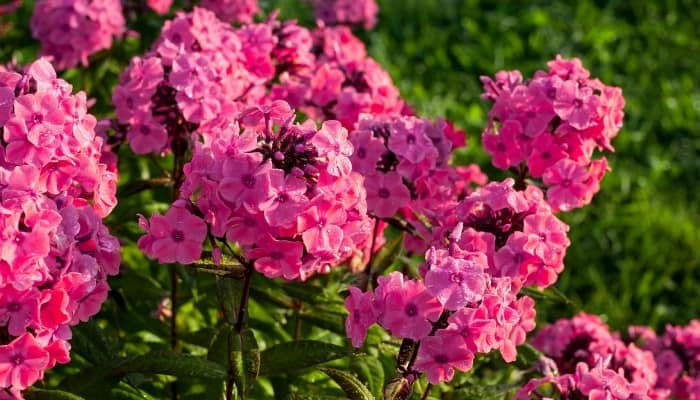
Phlox is an excellent border plant and grows well with daylilies.
Their upright stems with full, sturdy, domed-shaped flowers provide vibrant spring to late summer color, which complements the daylily perfectly.
Phlox enjoy the same free-draining soil as the daylily and appreciate full sun or light shade.
- Botanical name: Phlox paniculata
- Average size: Height 6 inches – 5 feet depending on the variety
- Colors available: Rose, magenta, purple, blue, pink, white
- Popular varieties: David Phlox, Volcano Ruby Phlox, Starfire Phlox
9. Roses
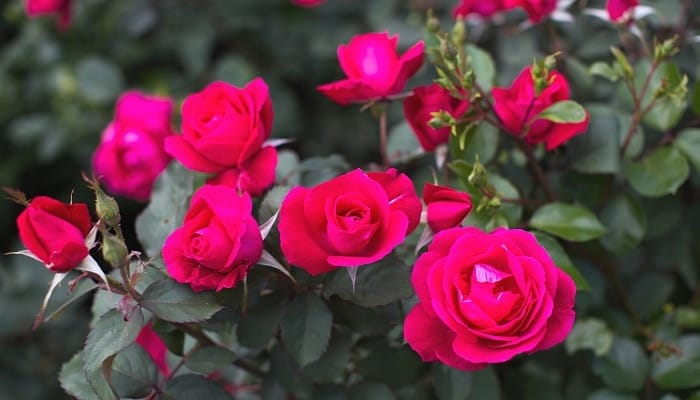
Roses and daylilies are perfect companions. Daylilies come into flower just as the first flush of roses has passed, thus maintaining a continuous colorful display.
In addition, the rose’s growth habits are similar, requiring large amounts of sun and rich, well-drained soil.
However, take care not to place the daylily in the shade of their rose companions.
- Botanical name: Rosa
- Average size: Height 4-6 feet (standard rose)
- Colors available: Red, white, yellow, pink, purple, multicolored
- Popular varieties: Tea Rose, Polyantha, Floribunda
10. Russian Sage
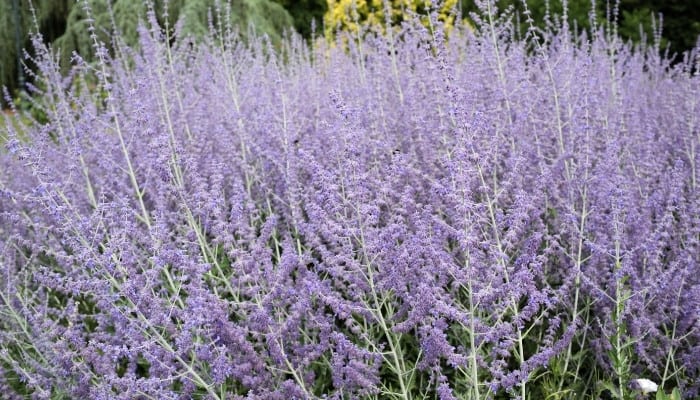
The purple upright spikes of Russian sage make this shrub a glorious companion to many late-summer perennials.
Grown alongside the daylily or in a central bed position, it is hardy, thrives in well-drained soil, and enjoys lots of sun.
- Botanical name: Perovskia atriplicifolia
- Average size: Height 47 inches, width 39 inches
- Colors available: Purple
- Popular varieties: Blue Mist, Blue Spire, Blue Jean Baby
11. Coral Bells
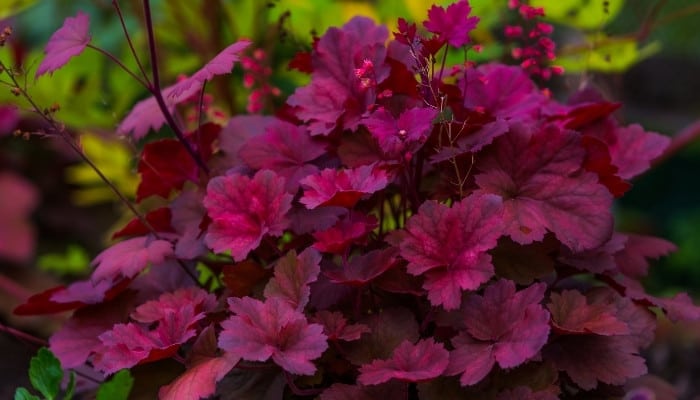
The foliage of the coral bells comes in shades of gold, green, rose, and purple. This plant is an excellent ground cover and looks great when grown in borders.
It requires full sun to partial shade and likes moist soil that drains well. It’s ideally suited as a companion plant to the daylily and provides delicate bell-shaped flowers in spring and early summer.
- Botanical name: Heuchera
- Average size: Height 8-17 inches, width 10-24 inches
- Colors available: White, coral, pink, orange, red
- Popular varieties: Green Spice, Marmalade, Chocolate Ruffles
12. Petunia
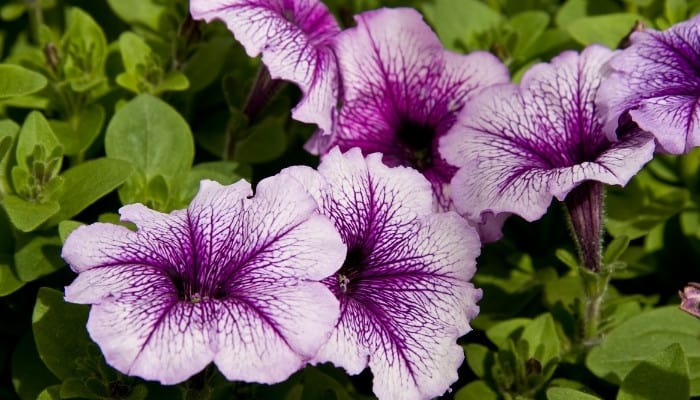
The petunia, with its various shapes and colors, is the perfect bedding or border plant. When paired with the daylily, it provides color throughout summer into autumn.
In addition, petunias enjoy full sun, fertile soil, and watering in dry conditions.
- Botanical name: Petunia
- Average size: Height 18 inches, width 3 inches
- Colors available: Pink, purple, white, red, blue, multicolored
- Popular varieties: Night Sky, Tumbelina, Crazytunia
13. False Sunflower
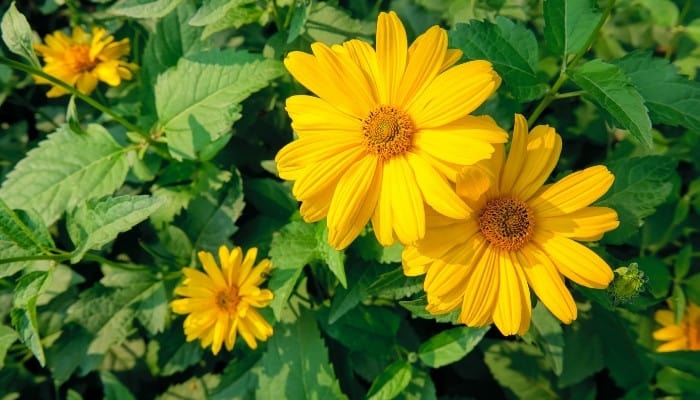
The false sunflower requires full sun and can tolerate drought conditions; however, moist, rich, well-draining soil is best.
Grown alongside or positioned as a backdrop for the daylily, it provides color and fullness throughout the summer.
- Botanical name: Heliopsis helianthoides
- Average size: Height 3 -6 feet, width 2-6 feet
- Colors available: Yellow, orange
- Popular varieties: Summer Nights, Prairie Sunset, Asahi
14. Sedum
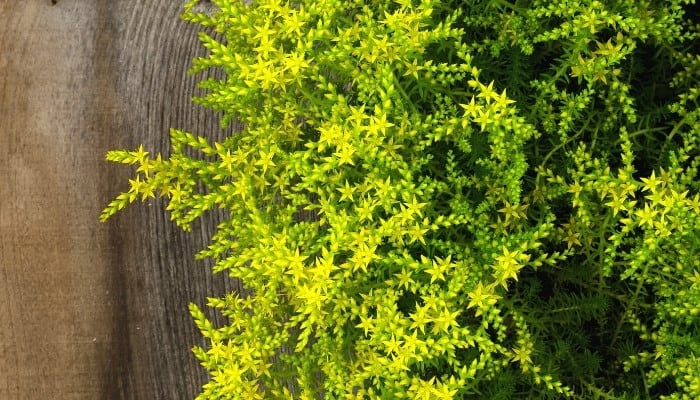
Sedum is an excellent groundcover providing lots of color and interest when grown with the daylily.
This succulent is exceptionally hardy, thrives in drought conditions, enjoys full sun, and requires little moisture.
Tiny blooms appear in the autumn, complimenting the last blooms of the daylily.
- Botanical name: Sedum
- Average size: Height 18 inches, width 18 inches
- Colors available: Yellow, purple, copper, green, red
- Popular varieties: Sedum acre, Sedum actinocarpum, Red Creeping
15. Iris

Irises require full sun and free-draining soil to prevent bulb rot. Thus, they are ideally suited as companions for daylilies who enjoy similar growing conditions.
In addition, their delicate ballerina-like flowers come in a range of colors, providing gorgeous splashes of color from early spring well into the summer.
- Botanical name: Iris spp.
- Average size: Height 2-3 feet
- Colors available: Blue, red, white, orange, pink, purple, multicolor
- Popular varieties: Iris Danfordiae, Iris reticulata, Bearded Iris, Siberian Iris
Conclusion
Planting companion plants can benefit plants from both a health and aesthetic point of view.
For example, some plants prevent certain pests or diseases and can protect nearby vulnerable plants.
However, companion planting also ensures your garden puts on a fantastic display of color throughout the changing seasons. Happy plant pairing!

